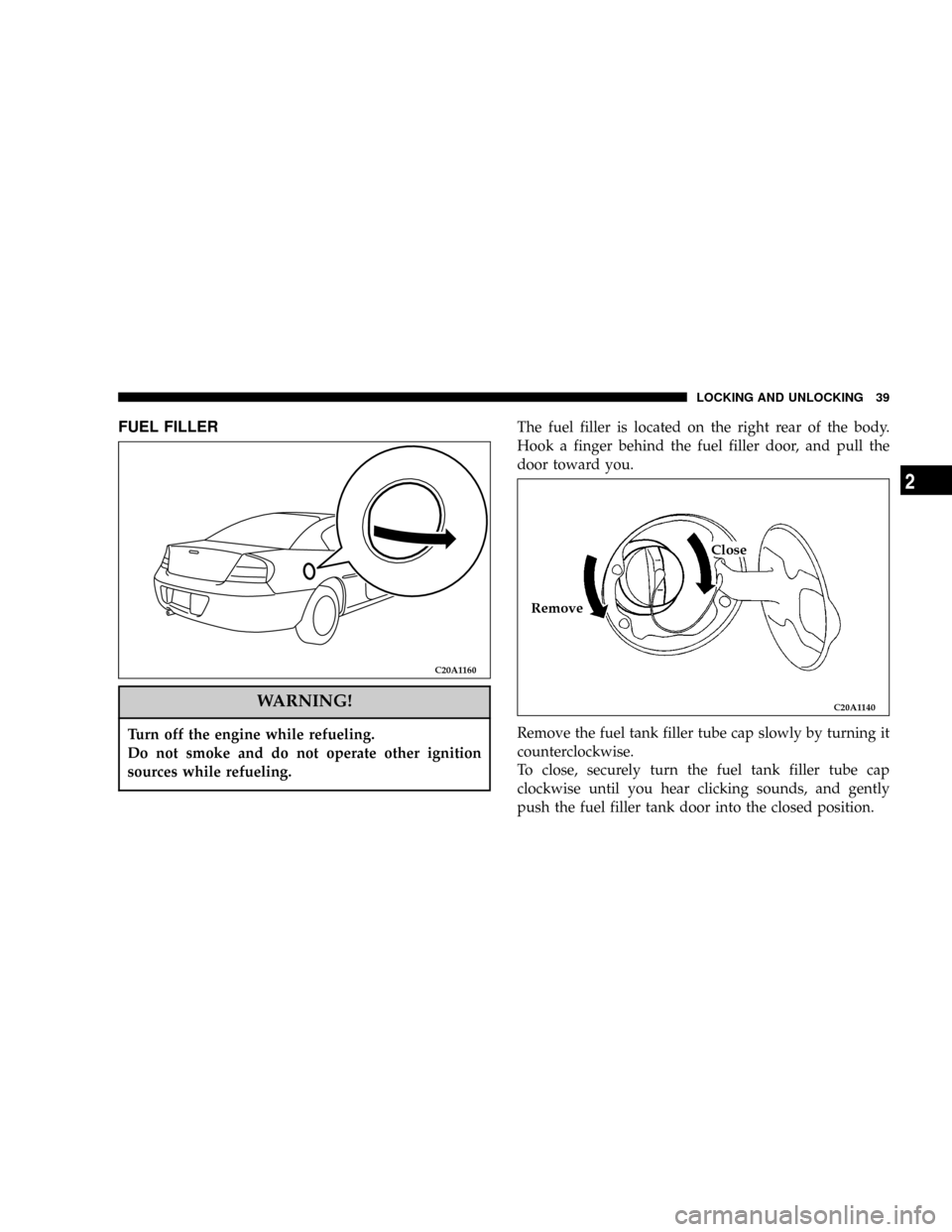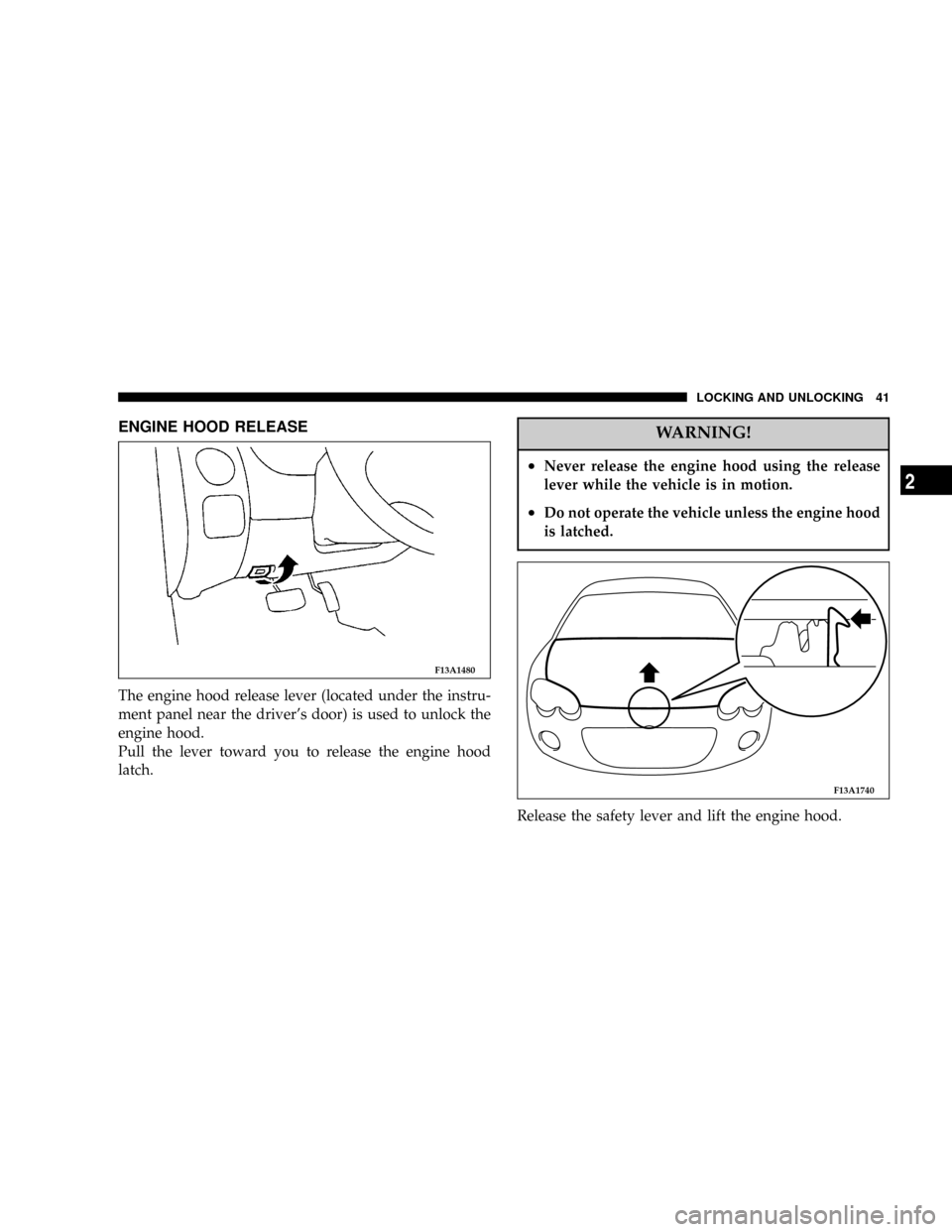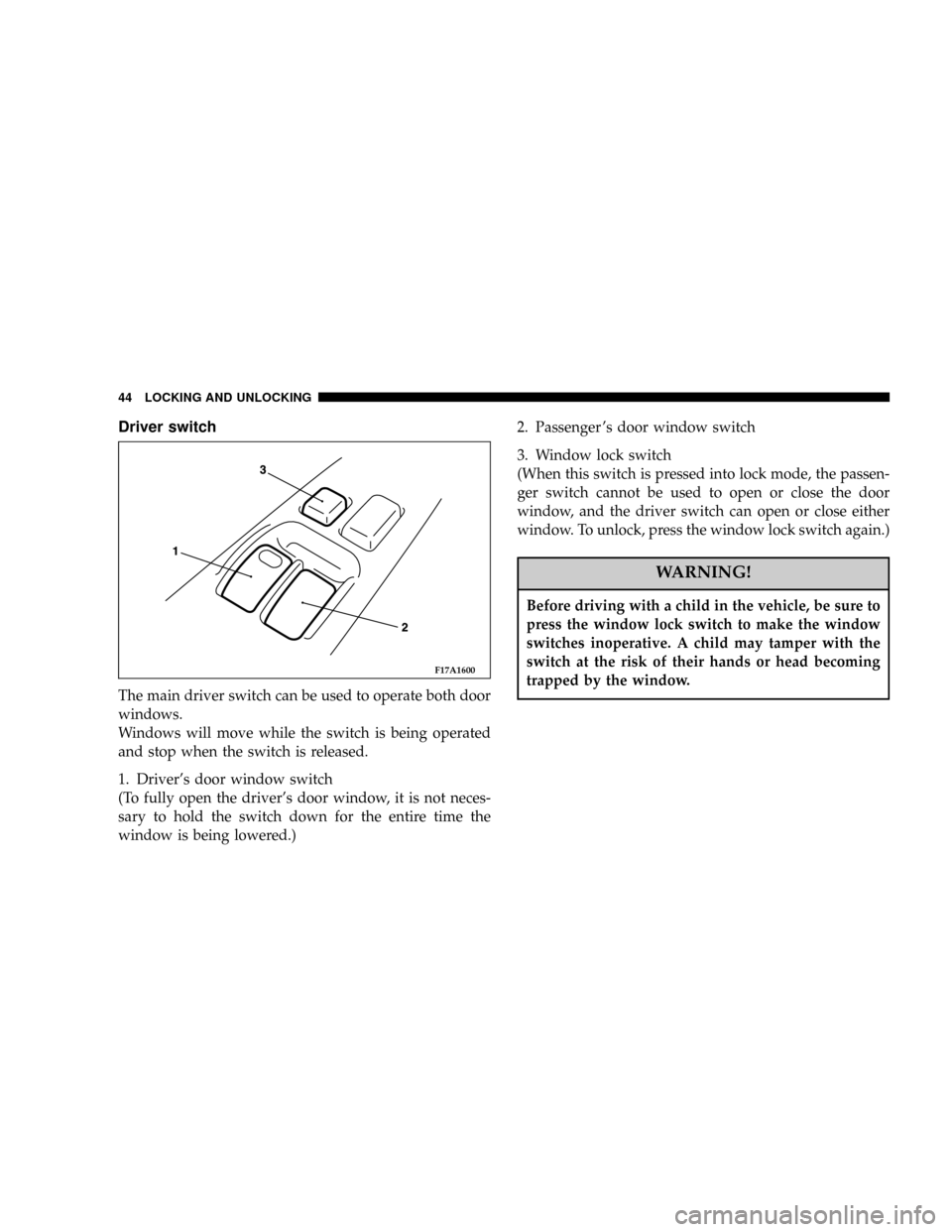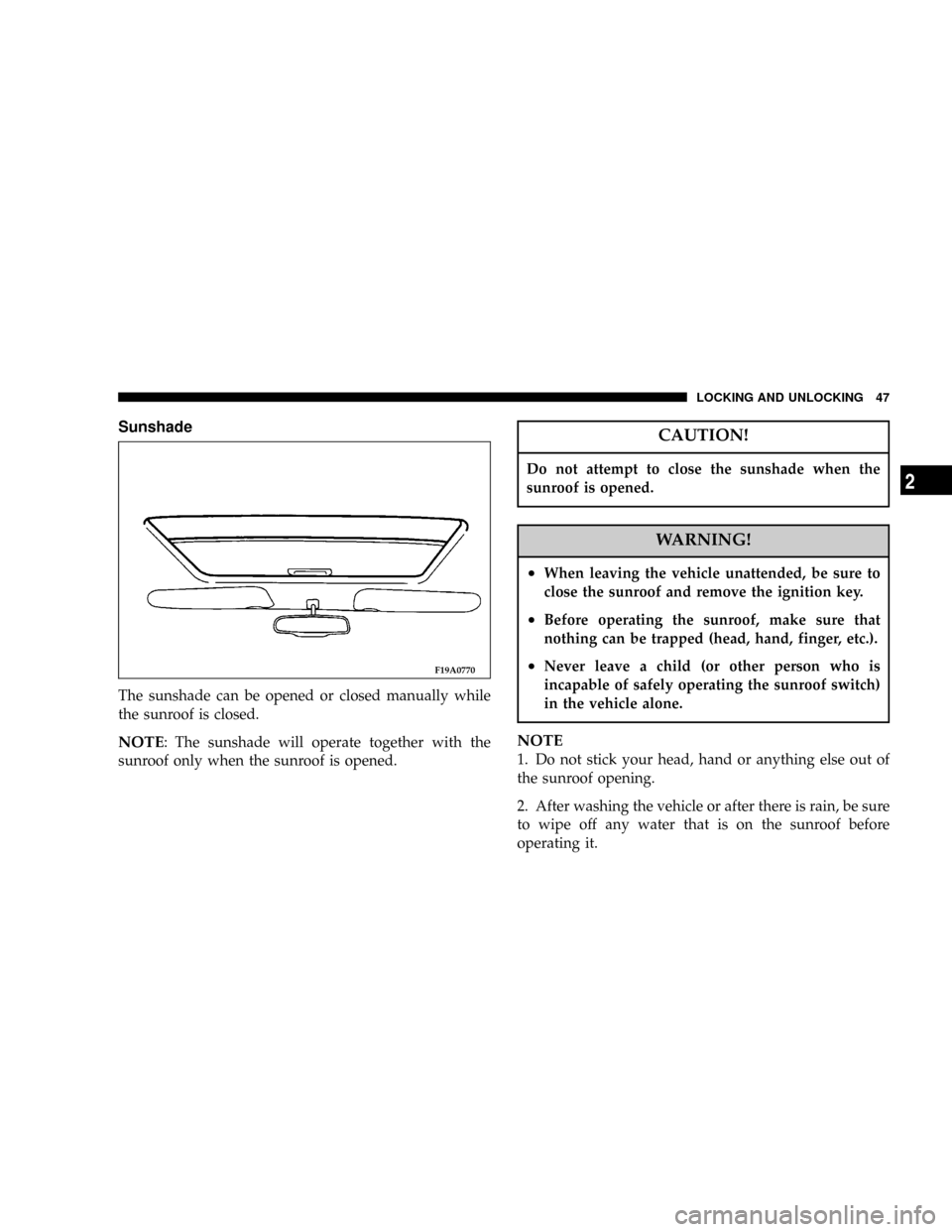warning CHRYSLER SEBRING COUPE 2004 2.G User Guide
[x] Cancel search | Manufacturer: CHRYSLER, Model Year: 2004, Model line: SEBRING COUPE, Model: CHRYSLER SEBRING COUPE 2004 2.GPages: 382, PDF Size: 2.23 MB
Page 35 of 382

Locking and unlocking with key or inside lock
knob
Using the key to lock or unlock the driver 's door will
automatically lock or unlock all of the doors.
·Turn the key inserted in the driver 's door lock once in
the unlocking direction, and the front driver 's door
will be unlocked.
·Give another turn in the unlocking direction, and both
doors will be unlocked.
Locking by means of the inside lock knob
Place the inside lock knob of the driver's door in the
locked position, and both doors will be locked.
TRUNK LID
WARNING!
²It is dangerous to drive with the trunk lid open
since carbon monoxide (CO) gas can enter the
cabin. CO is an invisible, odorless gas that can
cause unconsciousness and even death.
²Do not allow children to have access to the trunk,
either by climbing into the trunk from outside or
through the inside of the vehicle. Always close the
trunk lid when your vehicle is unattended. If
trapped in the trunk, it is possible to escape from
the trunk by using the inside emergency trunk
release handle. (See ``Inside emergency trunk re-
lease'' on Page 37).
F12B0710
Lock Unlock
Lock
LOCKING AND UNLOCKING 35
2
Page 36 of 382

CAUTION!
Do not stand behind the exhaust pipe when loading
and unloading luggage. Heat from the exhaust could
lead to burns.
To open the trunk lid
Press the TRUNK switch twice within five seconds.
(Refer to ``Keyless entry system'' on page 29.)
The trunk lid will unlock and rise slightly.
Lift it to open.
To close the trunk lid
Lower the trunk lid and push down with both hands
until it is locked.
Trunk-ajar warning chime
When the vehicle is moving at more than 5 mph (8 km/h)
and the trunk lid is open, a chime will sound to inform
the driver that the trunk lid is not properly shut.
Remote trunk lid release
Pull the trunk lid release lever, located to the left of the
driver's seat, up to open the trunk lid.
CAUTION!
Do not operate the trunk lid release lever while the
vehicle is moving. If the trunk lid opened, luggage
could fall onto the road and cause an accident.
F15A1770
36 LOCKING AND UNLOCKING
Page 37 of 382

Inside emergency trunk release
The emergency trunk release is designed to provide a way to
open the trunk lid from inside the trunk. It was developed to
help prevent death and serious heat-related injuries, includ-
ing brain damage, especially for children who might become
locked inside a vehicle trunk.
The illuminated9T9shaped yellow emergency trunk release
handle (see illustration) is mounted near the latch inside the
trunk lid. Velcro keeps the handle secure in its holder.The handle glows in the dark after exposure to sunlight.
You and your family should familiarize yourselves with the
location and operation of the emergency trunk release
handle. Children should be taught not to play in or around
vehicles.
WARNING!
²Children should never be left unsupervised in or
around vehicles.
²Unsupervised children could lock themselves in
an open vehicle or trunk.
²People trapped inside a vehicle, or trunk, even if
only for a short period of time, can quickly die
from suffocation or heat stroke, especially on hot
days. Interior temperatures in vehicles can rise in
minutes.
²Keep your vehicle doors locked and the trunk
closed when not in use. Keep your vehicle keys
away from children.
F15A2350
LOCKING AND UNLOCKING 37
2
Page 39 of 382

FUEL FILLER
WARNING!
Turn off the engine while refueling.
Do not smoke and do not operate other ignition
sources while refueling.
The fuel filler is located on the right rear of the body.
Hook a finger behind the fuel filler door, and pull the
door toward you.
Remove the fuel tank filler tube cap slowly by turning it
counterclockwise.
To close, securely turn the fuel tank filler tube cap
clockwise until you hear clicking sounds, and gently
push the fuel filler tank door into the closed position.
C20A1160
C20A1140
RemoveClose
LOCKING AND UNLOCKING 39
2
Page 40 of 382

Low fuel warning chime
If a chime sounds when the low fuel warning light is on,
that means the fuel is low.
NOTE: If the low fuel warning light goes off, then comes
back on again, the chime will not sound.
Fuel tank capacity 61.7 L (16.3 gal)
CAUTION!
²As the fuel system may be under pressure, remove the
fuel tank filler tube cap slowly. Removing the cap
slowly relieves any pressure or vacuum that might have
built up in the fuel tank. If the cap is venting vapor or
if you hear a hissing sound, wait until it stops before
completely removing the cap. Otherwise, fuel may
spray out and injure you or others.
²If you need to replace the fuel tank filler tube cap,
use only a cap specified for your model vehicle.
²To avoid fuel spillage and overfilling, do not ªtop-offº
the fuel tank again and again after filling.
NOTE: If the fuel tank filler tube cap is not tight while
driving, the ªMalfunction indicator light (SERVICE EN-
GINE SOON)º may illuminate when the onboard diag-
nostic (OBD) system performs its self check.
Always tighten the fuel tank filler tube cap until you hear
clicking sounds. The indicator light will go off after
driving several times. If the indicator light does not go
off, contact your authorized dealer as soon as possible.
40 LOCKING AND UNLOCKING
Page 41 of 382

ENGINE HOOD RELEASE
The engine hood release lever (located under the instru-
ment panel near the driver's door) is used to unlock the
engine hood.
Pull the lever toward you to release the engine hood
latch.
WARNING!
²Never release the engine hood using the release
lever while the vehicle is in motion.
²Do not operate the vehicle unless the engine hood
is latched.
Release the safety lever and lift the engine hood.
F13A1480
F13A1740
LOCKING AND UNLOCKING 41
2
Page 43 of 382

CAUTION!
Be careful that hands or fingers are not trapped
when closing the engine hood.
POWER WINDOWS
NOTE
1. The windows can be operated when the ignition key is
in the ªON ºposition. The door windows can be openedor closed for a 30-second period even after the ignition
switch is turned off. However, once the driver's door or
the front passenger's door is opened, the windows can-
not be operated until the ignition switch is turned on
again.
2. Never try to operate the driver switch and passenger
switch in opposing directions at the same time. Doing so
will cause the window to freeze in position.
3. Repeated operation with the engine stopped (key
ªONº) will run down the battery. Operate the window
switches while the engine is running.
WARNING!
²Before operating the power windows, make sure
that nothing can be trapped (head, hand, finger,
etc.) in the window.
²Never leave the vehicle without removing the key.
²Never leave a child in the vehicle alone.
F17A0250
Open
Close
LOCKING AND UNLOCKING 43
2
Page 44 of 382

Driver switch
The main driver switch can be used to operate both door
windows.
Windows will move while the switch is being operated
and stop when the switch is released.
1. Driver's door window switch
(To fully open the driver's door window, it is not neces-
sary to hold the switch down for the entire time the
window is being lowered.)2. Passenger 's door window switch
3. Window lock switch
(When this switch is pressed into lock mode, the passen-
ger switch cannot be used to open or close the door
window, and the driver switch can open or close either
window. To unlock, press the window lock switch again.)
WARNING!
Before driving with a child in the vehicle, be sure to
press the window lock switch to make the window
switches inoperative. A child may tamper with the
switch at the risk of their hands or head becoming
trapped by the window.
F17A1600
44 LOCKING AND UNLOCKING
Page 47 of 382

Sunshade
The sunshade can be opened or closed manually while
the sunroof is closed.
NOTE: The sunshade will operate together with the
sunroof only when the sunroof is opened.
CAUTION!
Do not attempt to close the sunshade when the
sunroof is opened.
WARNING!
²When leaving the vehicle unattended, be sure to
close the sunroof and remove the ignition key.
²Before operating the sunroof, make sure that
nothing can be trapped (head, hand, finger, etc.).
²Never leave a child (or other person who is
incapable of safely operating the sunroof switch)
in the vehicle alone.
NOTE
1. Do not stick your head, hand or anything else out of
the sunroof opening.
2. After washing the vehicle or after there is rain, be sure
to wipe off any water that is on the sunroof before
operating it.
F19A0770
LOCKING AND UNLOCKING 47
2
Page 56 of 382

WARNING!
²Do not attempt to adjust the seat while driving.
This can be dangerous.
²After adjusting the seat, make sure that the seat is
securely locked into position.
²Be sure to have the seat adjusted by an adult. If it
is adjusted by a child, the seat may not be prop-
erly locked into position.
WARNING!
²In order to reduce risk of serious or fatal injury in
a collision, including from a deploying front pas-
senger air bag, all front seat passengers should
move the front passenger seat as far back as
possible, all children 12 years old and under
should ride restrained in the rear seat, and all
children in rear-facing child restraints must ride
in the rear seat.
²In order to reduce risk of serious or fatal injury in
an accident, including from a deploying driver 's
side air bag, the driver should move the driver's
seat as far back as possible, while still maintain-
ing good visibility and good control of the steer-
ing wheel, accelerator and brake pedals.
NOTE: On vehicles with a power seat, to prevent the
battery from running down, operate the power seat with
the engine in operation.
56 SEATS, SEAT BELTS, CHILD RESTRAINTS AND AIR BAGS